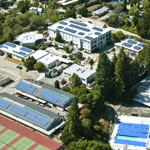In November 2012, the Santa Cruz City Schools (SCCS) in California hired Resource Solutions Group to assess the district’s potential water and energy conservation opportunities. The assessment found that the district could retrofit each of its 10 instructional campuses with new energy-efficient lighting and possibly make water-saving changes.
Adapting to environmental needs is not a foreign endeavor for SCCS. In 2009, the district installed 1,800 solar panels atop Soquel High School, and those panels now provide 50 percent of the school’s power. These energy savings contributed to the pursuit of even more environmentally friendly measures, leading to the assessment in 2012. “Our approach is to systematically look at the need and create a formal plan of attack,” says Alvaro Meza, Santa Cruz’s superintendent of business services.
The Resource Solutions Group recommendations that were approved by the school board were to be implemented this past summer before the 2013-2014 school year, Meza says.
The district hopes to fund the changes with help from Prop 39, an energy-efficiency initiative that requires multistate businesses to pay income taxes based on a percentage of their sales in California, and the revenue is then dedicated to energy-related projects.
The district expects to see the improvements save its schools enough in operational costs to refund any associated expense within two years. “We have a great opportunity to build upon what taxpayers and others want us to do, and ultimately save money,” Meza says.

Soquel High School was the Santa Cruz Green Schools Committee’s first project. A student from each secondary school’s environmental club serves on the GSC, and its past efforts have included beach clean-ups and natural habitat restorations.
SCCS’s ongoing commitment to creating sustainable spaces is due in part to its Green Schools Committee (GSC), founded in 2009.
The committee of 25 to 30 students, parents, and teachers meets monthly to undertake conservation projects and discuss potential new environmental efforts—such as the 30 percent recycled material paper purchasing policy that the group encouraged the district to adopt several years ago.
“Our Green Schools Committee is really a strength,” Meza says. “We get stakeholder feedback from the community, parents, and students that use the facility and staff that work in them.”
As part of its role in making recommendations to the district’s governing board, the GSC will review preliminary designs that SolarCity, the renewable electricity provider that installed Soquel High School’s solar panels in 2009, submitted to potentially add carports covered in solar panels to four school sites in the coming year, adding to the energy production of the whole district.
SolarCity would construct and maintain the carports, offering SolarCity a tax benefit and helping the schools reduce energy use. “Investing in our facility and being good stewards of the environment, as well as providing a financial benefit, is the ultimate goal,” Meza says. “It’s what we strive for in pretty much everything we do.”

